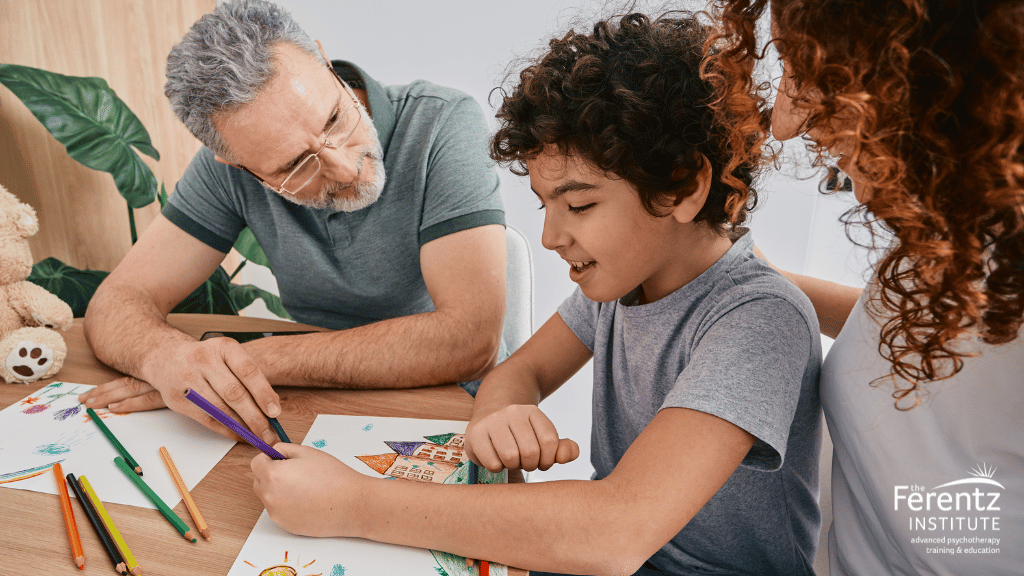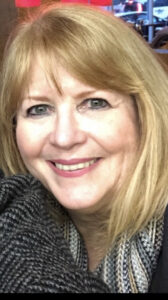by Peggy Kolodny, MA, ATR-BC, LCPAT

As an art psychotherapist specializing in trauma treatment for over 40 years, I am passionate about my profession. I have been fortunate to have learned alongside many of the trauma treatment pioneers and have witnessed the field evolve over these past 4 decades! The unlikely marriage of mindfulness and neuroscience certainly impacted our perspectives and approaches.
Along my clinical journey, I have trained formally in EMDR and IFS, and taken multiple workshops in Neurosequential Model of Therapeutics (NMT), and other neurobiological models, sensory somatic models as well as dissociation and dissociative disorders. My art therapist mind, in all these trainings, became a creative brainstorm, considering all the ways to integrate creative interventions with all these trauma theories, an integrative art therapy approach was born!
The Genesis of a New Art Therapy Technique
As an example, from day one of my EMDR training, I realized I could use bilateral scribbling as a form of bilateral stimulation in Phase 4 of EMDR. In IFS, I have my clients create their parts in clay to dialogue with each other. I have clients draw their sanctuary “safe” place, a foundational part of building resources in all trauma treatment. I use body outlines for clients to draw where they notice somatic (felt) sensations, affect, and even their “parts”, their self-states, in their bodies, (even dissociative parts have found their voice through art-making!)
When child victims are often told not to tell, they weren’t told they couldn’t draw their stories. The art narrative often becomes the first place their voices can be heard without saying it out loud in a way that feels non-threatening. Such powerful moments.
A common concept, taught as a mantra from diverse trauma theories, is we need low verbal approaches in therapy as we learn that trauma experiences are stored in our bodies somatically and via all of our senses. Neurobiology has taught us how our triune brains react “from the bottom-up” to both the original trauma and any life moments reminding us both unconsciously and consciously of unresolved fears. Our brain stems and limbic systems, informed by trauma sensitized neural pathways, seek to protect us from further dangers. Our cortex may become inaccessible as we focus on survival. Think flight, fight, freeze and more. Sometime “freeze” results in Brocha’s Response, a neurological shutdown in our brains that diminishes the ability to speak. Who hasn’t had a nightmare where they tried to scream and couldn’t? And in real life? I remember pointing to my toaster on fire and all that came out was “arghhh”!
And, along with neurobiological functions, we humans possess the amazing survival ability to develop “parts” of us to help us survive and even thrive. As IFS ( Internal Family Systems) teaches us, we all have parts, even those of us who have not experienced complex traumas. There is a “multiplicity of the mind.”
So, we’ve learned that sometimes words aren’t enough, and that’s where the low-verbal and sensory and somatic qualities found in the expressive arts come into play. Art, drama, movement, music, creative writing, sand tray/play, and play therapy all are such powerful psychotherapeutic models and modalities. Expressive arts are incredibly flexible, and they fit right in with most trauma treatment approaches. These creative therapies share a common thread with trauma models—they’re all about compassion, strength-based, and putting the client, at the center of the process.
The Therapeutic Advantages of Art-Based Interventions
Another mantra therapists are taught is it’s all about the therapeutic relationship, no matter what our clinical leanings may be. Early attachment experiences play a big role in how trauma affects us, and that’s where art-making in therapy provides huge benefits.
My clients have told me they love that I sit next to them at the art table, not across from them, and can offer them the gift of art supplies, nurture through witnessing of their creative process, and support their wordless narratives with compassion and empathy. It gives us a chance to build healthier relationships with ourselves and others by tapping into our sensory and somatic memories in a more natural, organic way.
As art-making is a sensory somatic process, and memories are stored in a similar manner, it makes sense that art will tap into these memories in a more accessible and less threatening way. As I often tell my clients, you don’t need talent or skill to use art in therapy. There is healing power in just putting paint on paper, finding ways shapes and colors match their feelings. We aren’t expecting “pretty pictures” we offer a way to express their messy feelings. It lets them step back from their emotions and gives them a safer space to work on tough feelings. The paper, the sculpture, the canvas, actually become a container to hold their feelings and memories outside of their body! We know how much relief we feel when we can express ourselves and feel heard and understood! They can’t look at their art and explore the stories it tells from their past, taking things one manageable step at a time, without being overwhelmed and flooded with feelings. This aligns with the concept found in EMDR of “dual awareness”, sitting in the present while observing the past.
Introducing Bilateral Drawing into Art-Making
In regards to bilateral movement and the Neurosequential Model, amazingly, art therapists have been using bilateral drawing for nearly 80 years! Bilateral means drawing with both hands at once or switching between them, or any bilateral movement, and these actions can offer great benefits for your brain. Bilateral actions and drawings can help you calm down, focus, and feel more grounded. Plus, it’s an effective way to connect different parts of your brain and process all types of memories. We can connect our emotions to our thoughts as bilateral movement connects both sides of our brains. Walking, playing piano, knitting, riding a bike, dancing, swimming are all natural ways we use bilateral movement everyday and we know these activities help us feel good.
Art-making is actually a natural part of your brain’s development, and overlaps perfectly with Perry’s Neurosequential Model. This model helps us heal our brains in a specific order, from the bottom up, almost like rewinding the clock and giving the chance to experience what you needed and missed out on as a child, such as learning to be soothed , allowed to name your feelings, talking about yourself. Expressive art and play are fantastic tools for this. For instance, if you never had the soothing experience of being rocked as a baby, gentle scribbling, bouncing on an exercise ball, or rhythmic drumming can help your brain learn new ways to calm yourself.
There are so many creative ways to match each stage of your brain’s development, starting from the bottom up. I’ve developed a method I call the Neurosequential Art Approach, which includes hand mudras, bilateral scribbling, mirroring art exercises, drawing breath, and using all the expressive arts to create a “Squiggle Story.” This art process helps you learn to organize the chaos from trauma’s impact, give your art emotional meaning, put words to your experiences, and understand these coping skills to repair your unhealed wounds, building hope and resiliency as you move forward to have the life you want. Art-making actually helps us experience and embody these benefits, making real the possibilities of transformation! Bilateral and Neurosequential art processes allows us to use our whole brains in healing and reparative manners.
If you’d like to learn more about this unparalleled creative approach to healing trauma, I hope that you will join me in person when I present “Scribble, Squiggle and Wiggle: Bottom Up and Bilateral Creative Approaches to Healing Trauma” with The Ferentz Institute. My workshop will be held on Tuesday, September 19 from 8:45 to 4:15 PM at the Hilton Garden Inn located in Owings Mills, Maryland. To learn more and register for this workshop, click here.

About Peggy Kolodny
Peggy is an IFS and EMDR practitioner, making her one of the few art therapists practicing an integrative approach with advanced training in both these models. She graduated from George Washington University, earning her MA ATR-BC LCPAC, and is a Board -Certified, Licensed Art Psychotherapist with level 2 certificates in EMDR and IFS. Peggy has specialized in trauma treatment since 1982. She founded the Art Therapy Collective, a private practice in Owings Mills, Maryland. Learn more about Peggy here.

